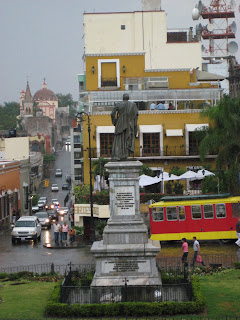




 These are some of the artifacts from the indigenous cultures surrounding what is now Cuernavaca. They are all housed within the great Hacienda de Cortes museum. Outside of the museum sits a Cuexcomate (Cuesh-co-mah-te), used as a symbol of wealth; people would store things in their Cuexcomates, therefore, the more things that one had, the more Cuexcomates one had. And these could be found right outside of their thatched-roof homes, in their yard. The stone statue-like figure is from Xochicalco, also in the state of Morelos. The other two stone sculptures show a possible writing system and the elongated stone with the face on it displays certain Olmec characterisitcs. The last image is of a page found within an indigenous paper-book from the 16th century. It is very fascinating to be able to get a close look at all of these artifacts, the material culture of the indigenous peoples from within and around Cuauhnahuac.
These are some of the artifacts from the indigenous cultures surrounding what is now Cuernavaca. They are all housed within the great Hacienda de Cortes museum. Outside of the museum sits a Cuexcomate (Cuesh-co-mah-te), used as a symbol of wealth; people would store things in their Cuexcomates, therefore, the more things that one had, the more Cuexcomates one had. And these could be found right outside of their thatched-roof homes, in their yard. The stone statue-like figure is from Xochicalco, also in the state of Morelos. The other two stone sculptures show a possible writing system and the elongated stone with the face on it displays certain Olmec characterisitcs. The last image is of a page found within an indigenous paper-book from the 16th century. It is very fascinating to be able to get a close look at all of these artifacts, the material culture of the indigenous peoples from within and around Cuauhnahuac.



 And here are some of the murals painted by Diego Rivera, demonstrating the power and impact of the Spaniards. The indigenous peoples of Mesoamerica were never considered to be "gente de razon", or people of reason so the Spanish Inquisition supposedly never subjected them to any of its trials, rules, laws and regulations (unlike the African slaves who were brought to the "New World" and because they were from the "Old World", of course they were subjected to the requirements and belief system established and maintained by the Inquisition). But these murals are quite impressive; there aren't as many as at the Palacio Nacional in Mexico City, but I enjoyed being able to see them.
And here are some of the murals painted by Diego Rivera, demonstrating the power and impact of the Spaniards. The indigenous peoples of Mesoamerica were never considered to be "gente de razon", or people of reason so the Spanish Inquisition supposedly never subjected them to any of its trials, rules, laws and regulations (unlike the African slaves who were brought to the "New World" and because they were from the "Old World", of course they were subjected to the requirements and belief system established and maintained by the Inquisition). But these murals are quite impressive; there aren't as many as at the Palacio Nacional in Mexico City, but I enjoyed being able to see them.



2 comments:
What great pictures! I love seeing all the artifacts. Thanks for always sharing so many wonderful pictures and details..I live vicariously through you!
Very cool, it makes me want to learn more about all of this, and especially be able to pronounce all of these names. I have to say the x in names really throws me! But it sounds like you had a great weekend and I am so glad you could go!
Post a Comment